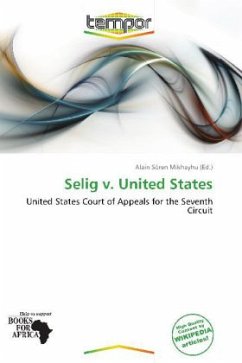Please note that the content of this book primarily consists of articles available from Wikipedia or other free sources online. Selig v. United States, 740 F.2d 572 (1984), is a case decided by the United States Court of Appeals for the Seventh Circuit related to the amortization of intangible property. Conceptually, amortization is a mechanism that allows taxpayers to recover the cost of property over the life of an asset when they are precluded from taking an immediate and full deduction. Practically, this means that taxpayers may recover the cost in small amounts over time. There are two forms of such recovery: depreciation and amortization. Selig deals with amortization. The general rule for amortization is set forth in Section 197 of the Internal Revenue Code. The Selig case demonstrates some of the practical problems in cost allocation prior to the enactment of Section 197.
Bitte wählen Sie Ihr Anliegen aus.
Rechnungen
Retourenschein anfordern
Bestellstatus
Storno


![United States Circuit Courts Of Appeals Reports: With Key-number Annotations ... V. 1-171 [1891-1919] United States Circuit Courts Of Appeals Reports: With Key-number Annotations ... V. 1-171 [1891-1919]](https://bilder.buecher.de/produkte/65/65043/65043715m.jpg)
![United States Circuit Courts Of Appeals Reports: With Key-number Annotations ... V. 1-171 [1891-1919] United States Circuit Courts Of Appeals Reports: With Key-number Annotations ... V. 1-171 [1891-1919]](https://bilder.buecher.de/produkte/65/65115/65115692m.jpg)
![United States Circuit Courts Of Appeals Reports: With Key-number Annotations ... V. 1-171 [1891-1919] United States Circuit Courts Of Appeals Reports: With Key-number Annotations ... V. 1-171 [1891-1919]](https://bilder.buecher.de/produkte/65/65149/65149286m.jpg)
![United States Circuit Courts Of Appeals Reports: With Key-number Annotations ... V. 1-171 [1891-1919] United States Circuit Courts Of Appeals Reports: With Key-number Annotations ... V. 1-171 [1891-1919]](https://bilder.buecher.de/produkte/65/65058/65058151m.jpg)

![United States Circuit Courts Of Appeals Reports: With Key-number Annotations ... V. 1-171 [1891-1919] United States Circuit Courts Of Appeals Reports: With Key-number Annotations ... V. 1-171 [1891-1919]](https://bilder.buecher.de/produkte/65/65064/65064438m.jpg)
![United States Circuit Courts Of Appeals Reports: With Key-number Annotations ... V. 1-171 [1891-1919] United States Circuit Courts Of Appeals Reports: With Key-number Annotations ... V. 1-171 [1891-1919]](https://bilder.buecher.de/produkte/65/65143/65143662m.jpg)